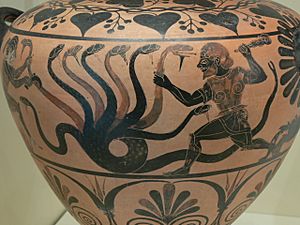Hydra (mythology) facts for kids
| Parents | Typhon and Echidna |
|---|---|
| Mythology | Greek mythology |
| Other name(s) | Lernaean Hydra |
| Country | Greece |
The Lernaean Hydra, often just called the Hydra, is a scary water monster from Greek and Roman mythology. It looked like a giant snake with many heads. Its home was a lake called Lerna in ancient Greece. People believed Lerna was a secret entrance to the Underworld, the land of the dead.
The most famous story about the Hydra is when the hero Heracles (also known as Hercules) fought and defeated it. This was the second of his Twelve Labors, a series of difficult tasks he had to complete.
Contents
Origin of the Hydra
According to ancient Greek writers like Hesiod, the Hydra was the child of two powerful and monstrous beings: Typhon and Echidna. These parents were known for creating many other famous monsters in Greek myths.
The Hydra was incredibly dangerous. Its breath was poisonous, and its blood was so deadly that even its smell could harm you. The monster had many heads, though the exact number changes in different stories. Some tales say it had five, while others claim it had a hundred!
What made the Hydra even scarier was its special power: regeneration. This meant that if you cut off one of its heads, two new ones would grow back in its place! Heracles needed special help from his nephew Iolaus to finally defeat this regenerating beast.
Heracles' Second Labor: Battling the Hydra
Eurystheus, the king of Tiryns, ordered Heracles to kill the Hydra. The goddess Hera, who disliked Heracles, had raised the Hydra specifically to try and defeat him. Heracles traveled to the swamp near Lake Lerna, where the monster lived.
To protect himself from the Hydra's poisonous fumes, Heracles covered his mouth and nose with a cloth. He found the Hydra's lair, a deep cave called the spring of Amymone. The monster would only come out of this cave to terrorize nearby villages.
Heracles shot flaming arrows into the cave to force the Hydra out. When it appeared, he attacked it with his club, a sword, or sometimes a sickle, depending on the story. But as soon as he cut off one head, two more grew back! Heracles quickly realized he couldn't win this way. The Hydra was only vulnerable if it had no heads left.
Iolaus's Clever Help
Seeing that his usual strength wasn't enough, Heracles called for help from his nephew, Iolaus. Iolaus had a brilliant idea, possibly inspired by the goddess Athena. He suggested using fire to stop the heads from growing back.
As Heracles cut off each head, Iolaus would immediately use a burning torch to burn the open neck stump. This stopped new heads from growing. While they were fighting, the goddess Hera sent a giant crab to distract Heracles. But Heracles quickly crushed the crab under his powerful foot.
Finally, Heracles used a special golden sword, given to him by Athena, to cut off the Hydra's one immortal head. This head couldn't grow back. He then buried the still-wriggling immortal head under a huge rock on a sacred path. After this, Heracles dipped his arrows into the Hydra's poisonous blood, making them deadly. His second task was complete!
Aftermath and Consequences
There's another version of the myth where Heracles dipped his sword into the Hydra's neck after cutting off a head. He then used the monster's own venom to burn the stumps, preventing regrowth.
Hera was very angry that Heracles had defeated the monster she had raised to kill him. To honor the Hydra and the crab, she placed them in the night sky as the constellations Hydra and Cancer.
Heracles later used his arrows, now coated in the Hydra's deadly poison, to defeat other enemies in his remaining labors. For example, he used them against the Stymphalian Birds and the giant Geryon. He also used a poisoned arrow to kill the centaur Nessus. Nessus's poisoned blood later led to Heracles' own death, showing the lasting power of the Hydra's venom.
King Eurystheus, who had given Heracles the labors, refused to count the Hydra's defeat as one of the ten tasks. He argued that Heracles had received help from Iolaus, so he hadn't completed the labor alone.
The Hydra in the Stars
Ancient Greek and Roman writers believed that the goddess Hera placed the Hydra and the crab among the stars. She did this after Heracles killed them, so they would forever be seen in the night sky.
When the sun is in the sign of Cancer (which means "The Crab" in Latin), the constellation Hydra's head is nearby. Both of these constellations actually came from even older Babylonian star patterns. The Babylonians had signs for "The Venomous Snake" (Bashmu) and "The Crayfish" (Alluttu).
In art
-
John Singer Sargent (1921)
-
Reverse of a 1914 medal by Fritz Eue commemorating General Erich Ludendorff
-
Portrait of Henri IV as Hercules pinning the Hydra of Lerna, an allegory of the Navarrese king's defeat of the Catholic League during the French Wars of Religion. Workshop of Toussaint Dubreuil, c. 1600.
See also
 In Spanish: Hidra de Lerna para niños
In Spanish: Hidra de Lerna para niños





